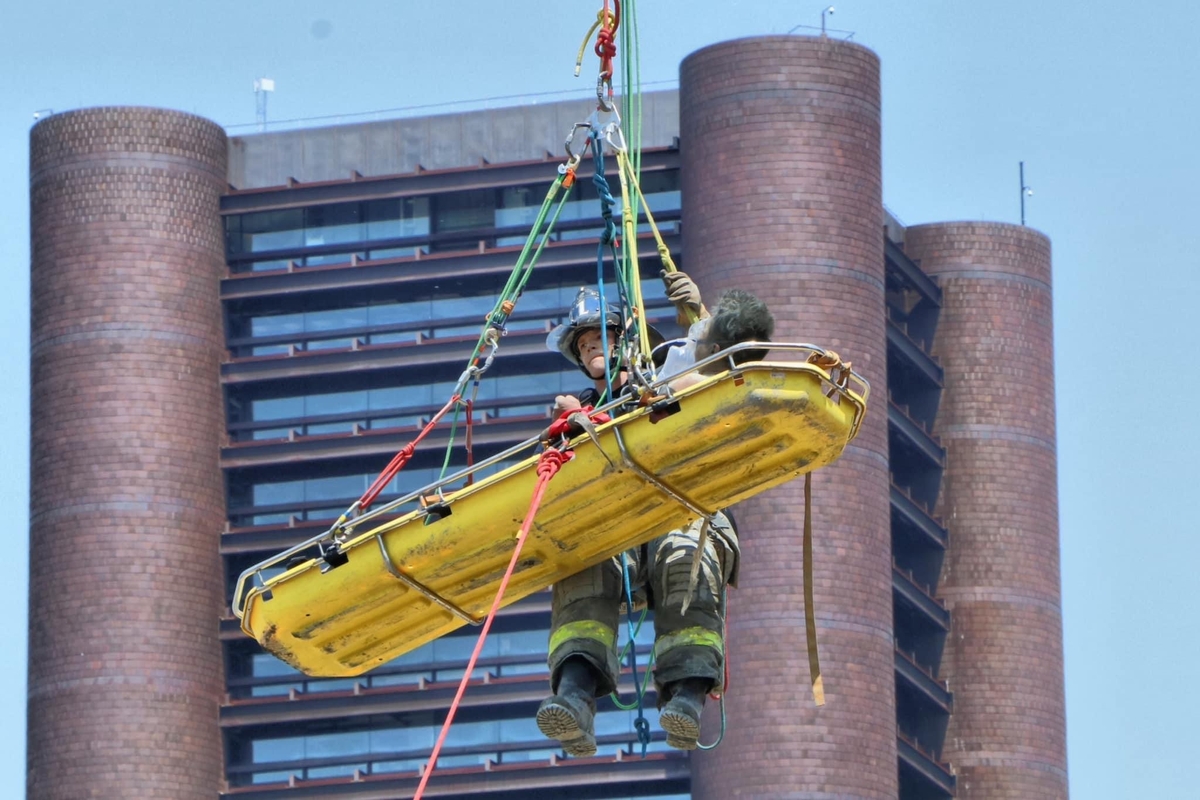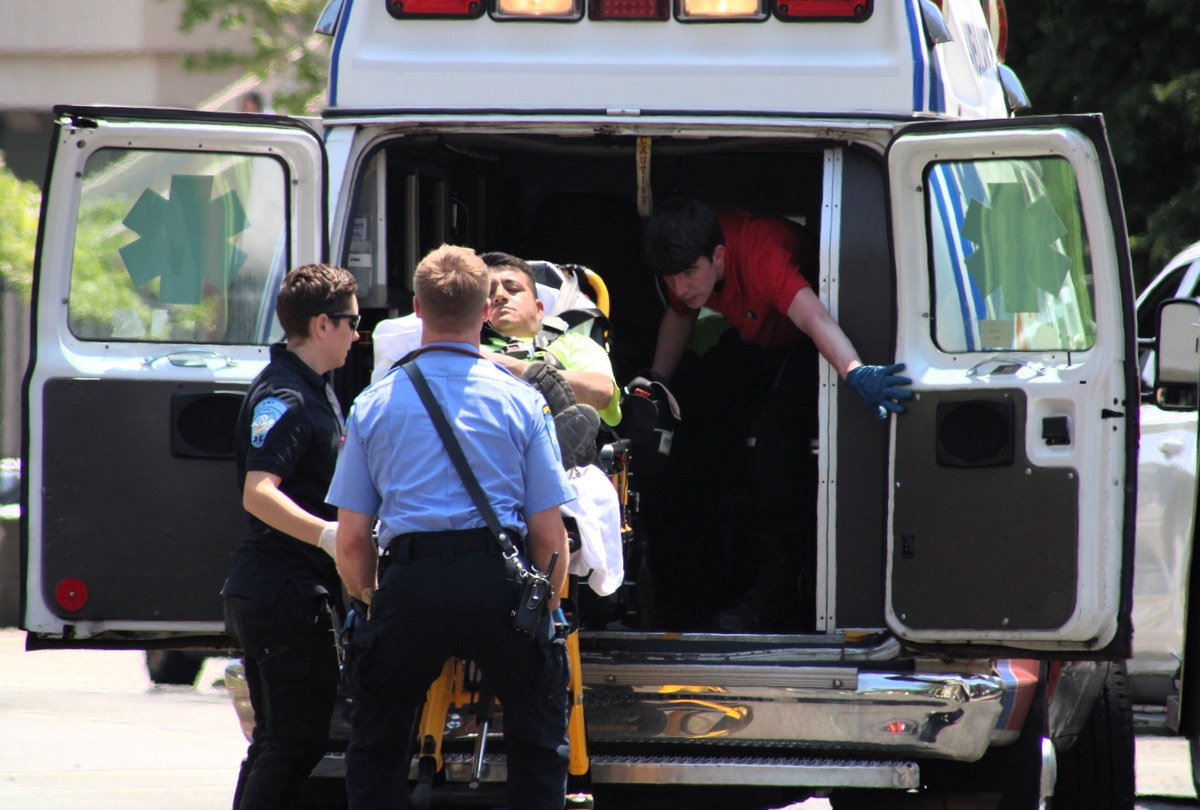
Daniel Coughlin file photo
Firefighter Nathaniel Peragallo accompanies rescued construction worker on aerial rescue.
Capt. Ryan Almeida looked down into a 30-foot hole where a concrete deck had collapsed and a construction worker was now buried in rubble. He and his crew had to figure out a way to pull the man out. Fast.
It wasn’t going to be simple.
Almeida and the New Haven Fire Department rescue company he oversees faced that challenge on Friday afternoon after an apartment building under construction on Lafayette Street partially collapsed.
They moved fast, but carefully, amid danger to themselves to save the life of a laborer for an Orange-based company called Seven Concrete while helping to build the sixth new apartment complex rising on a former Urban Renewal-leveled asphalt stretch of the Hill neighborhood. (Eight workers in all were hospitalized. As of Monday morning, six of the eight workers had been released, according to Yale New Haven spokesperson Mark D’Antonio. Two workers remained hospitalized and listed in fair condition. One of them, who sustained the most severe injuries, is a 24-year-old worker named Juan Solano; it could not be confirmed at the time of publication of this article that he was the same worker whom the NHFD rescued from the rubble.)
“It was the most impressive rescue I’ve ever seen on my 21 years on this job,” said Assistant Fire Chief Daniel Coughlin.
“Think about what they did: The person fell 30 feet in the wet concrete. They dug him out by hand with hand shovels. They set up a rigging system to haul him out of that hole. They attached it to Truck 1, the aerial ladder, and set up a hauling system. The hauling system pulled him up. Then the Truck 1 driver painstakingly moved that aerial ladder without jerking it” and brought the construction worker, unconscious but alive, out to Lafayette Street and into an ambulance to the hospital, where his condition has improved from critical to fair.
Three days later, Almeida on Monday walked the Independent through each step of that rescue in an interview.
Almeida was riding in the front of the department’s rescue truck and firefighter Jason Rivera was behind the wheel when the call came in Friday at 12:38 p.m. about a partial building collapse. They were headed back to the Whitney Avenue station from the Ella Grasso Boulevard fire training facility, where Almeida, who oversees the rescue company, had conducted a practice rescue of a firefighter stuck up on a high ladder.
They didn’t know much about the call they were responding to as Rivera steered toward the partial collapse at 188 Lafayette St., in the heart of the “Hill-to-Downtown” redevelopment area where builder Randy Salvatore has been erecting a mini-city of medical district-marketed apartment complexes under the banner of “City Crossing.” This latest building is slated to rise seven-stories with 112 apartments.
Almeida’s crew arrived within minutes. They grabbed metal cutting saws and hand lights.
“We didn’t know what we were going into,” but they knew it would be dark.
Seven Concrete workers directed Almeida to a portable ladder rising to an upper deck they were pouring.
Almeida began climbing that ladder when other workers yelled, “It’s not up there! It’s not up there!”
He did a glimpse of the giant hole that formed from the collapse in the interior of the building, with rebar overhanging into it.
Another construction worker directed Almeida’s crew to an entrance to the below-ground deck where people were trapped.

Almeida and Rivera climbed another construction ladder down followed by fellow firefighters Nathaniel Peragallo, James Kiley, and Jason Lyman. On the first subterranean level, they learned they needed to descend another tier to reach the trapped workers.
Watching every step, they wove their way past wood shoring and screw jacks, adjustable temporary columns for extra support while concrete hardens.
“I looked down into the collapse and saw seven, eight, nine workers working with a metal cutting saw and shovels attempting to dig out someone that was trapped in the wet concrete,” Almeida said.
The firefighters would need to take the risk of entering themselves: “This is wet concrete. You had a worker buried face down. We obviously know you can’t survive face down in concrete.”
But they couldn’t safely climb the ten feet into the collapse area: “There was no possible way for us to climb down without pulling rebar on top of us.”
So the firefighters went down a different ladder to the lower level. Wading through knee-high wet concrete, they climbed over wood shorting and chunks of concrete to reach the trapped worker.
Adrenaline helped: “Everybody was extremely calm, cool under pressure.”
The firefighters took over from the construction workers in removing the trapped man. Kiley and Peragallo used hand shovels, then, when they got closer to man’s face, their bare hands to remove him from the rubble.
Meanwhile, Almeida scanned the area. He kept in communication with colleagues to determine what else might collapse, and who else might be missing. “We didn’t want somebody else to get trapped. We didn’t want more things to fall down. We had concrete that was in the hardening process.”
Other workers were injured, but none others trapped. Almeida sent firefighter Lyman back up to assess the conditions of injured workers on the upper level and report back to Battalion Chief Joseph Hilbert, who had assumed command of the full operation.
Which Way Out?
The next challenge: How will everyone else get out of the bottom level?
“I’m taking a quick look around. I can see that there’s other shoring that is compromised. I can see that there are screw jacks on the other floors that are racked to the side or missing. We probably have 25 feet of rebar that went down with the collapse that’s still hanging over us. My main concern was if that rebar wasn’t properly tied together, it could come down on us at any time. I’m looking for ties on the rebar to see if it’s tied together. I can see some loose pieces.”
Almeida realized it would take too long and be too precarious to try to carry the man back out over the ladders on which the firefighters had climbed down. They would need an aerial rope rescue.
The department’s assistant drillmaster, Eric Riggot, was on scene and oversaw preparations for the rope rescue: It involved setting up a “three-to-one mechanical advantage” twin-tension rope system high up into the air on a truck ladder, then down into the hole.
Back two stories below ground, Kiley and Peragallo finished digging out the construction worker, who was unconscious. They checked his breathing, looked for signs of bleeding. They gave him supplemental oxygen.
Keith Kerr, a firefighter paramedic, came to the scene with a monitor and medical bags. Other firefighters brought a Stokes basket, which is hardened with attachments for ropes.
Almeida moved the construction workers and the firefighters up an incline to a point with no overhead obstructions or precarious rebar.

DANIEL COUGHLIN PHOTO
The ropes came down into the hole. The crew placed and secured the worker in the basket and attached it to the ropes. Then Peragallo was attached to the rope system alongside the basket to ride up as well.
Almeida sent the signal, and the haul began, lifting the worker and Peragallo high into the air above the changing New Haven skyline and back down onto the street, where an ambulance crew was ready to take over.
The firefighters still in the sub-basement gathered their equipment, did a last check for any remaining victims, then climbed back up wooden ladders to the street.
The rescue was over: Dozens of firefighters had succeeded in rescuing eight people in all.
The work was just beginning. They would remain on scene until 7 p.m. Almeida’s crew, Hilbert, and the city’s building inspector returned with state police cadaver dogs and then a structural engineer to search again and secure the area from further collapse.
The biggest job had concluded: Saving a life.
Almeida was asked how that feels.
“We’re doing our job. This is why we train hard every day,” he responded. “I ask a lot from the members that work for me. They perform strongly for me every single day.”

Thomas Breen file photo
Paramedics load one of the injured construction workers into ambulance.








This is an amazing story. It sounds miraculous that there were no fatalities and thankfully, the firefighters and other rescue folk are also safe and sound!!